07. Mar 2017 - DOI 10.25626/0060
Dr. Alexandra Wachter holds a PhD in history from the University of London, Queen Mary and is currently working as a researcher at Österreichische Gesellschaft für Zeitgeschichte, University of Vienna. Her research interests include Soviet and post-Soviet history, with a particular focus on memory cultures, as well as on space and architecture.
Ekaterina Shapiro-Obermair is a visual artist based in Vienna. In her practice she applies strategies of artistic research and expands the field of activities toward curating, ethnography and cultural studies. The majority of her projects deal with different aspects of Soviet and post-Soviet art and culture.

“It's a memorial to victims, either of the ghetto, or of the Holodomor”, a young man who introduced himself as Oleksandr informed us. We were standing outside the unfinished museum known as Territory of Terror on Chornovola Street to find out what the citizens of L’viv, as well as visitors knew and thought about the project; it turned out that most had, at best, a vague idea about what exactly lay behind the gate with the ominous inscription. Like Oleksandr, many of them quite justifiably assumed a connection with the Memorial to Victims of the L’viv Ghetto on the other side of the busy street, or wondered whether the inscription might be connected to the Holodomor, a topic that is actively promoted in current Ukrainian politics of memory. Still others just saw a restaurant – Neptun, prominently overseeing the surrounding wall and the empty square outside of it. The entire area is a pick ’n’ mix of visual icons borrowed from regional sites of mass murder and internationally known imagery of the Holocaust, that give no clear hints as to which dark aspects of L’viv’s history they might be referring to.
This article explores how museum creators, both privately and state employed, have gone about the task of producing ‘new’ narratives of Western Ukrainian history by initiating museums at original sites of terror and violence committed during the Second World War and in its aftermath. Although crimes committed in the Polish era and under German occupation are also mentioned, the emphasis is clearly on crimes committed under and by the Soviet regime. The main bulk of the article will be on the unfinished museum 'Territory of Terror Memorial Museum of Totalitarian Regimes' and its representation of the recent history. In order to show how this particular project fits within the broader context of current memoralization processes regarding Soviet history, we will briefly consider a number of other planned or already realized memorial sites and museums in the area as well as take a closer look at the ‘Museum on Lonts’koho. National Memorial Museum of Victims of Occupational Regimes’. The analysis is based on observations made during several field trips to L’viv between August 2015 and January 2017 whereby we visited museums, observed social practices, and conducted street and more formal interviews with representatives of historical narratives (Jewish, Ukrainian, Soviet, and Polish) and experts, such as curators, architects, and artists.
Around 2010 the mayor of L’viv, Andriy Sadovyi, commissioned Taras Choliy, a documentary film producer with a passion for Western Ukrainian history, to develop a museum at the site of the former Transit Prison #25. Between 1944 and 1955 it had been used by The People’s Commissariat for Internal Affairs (NKVD) to keep people in custody while they awaited deportation to the camps of the Soviet Gulag system; it was located next to a railway line, and on the territory of the former Jewish ghetto (1941–1943). According to the project’s website, it was one of Ukraine’s largest transit prisons. However, until recently, most of the inhabitants of L’viv knew the site only as the former military hospital for war veterans, which the area was converted to after 1955.
The erection of the museum building was completed in 2015, and the exhibition is yet to be finalized. Choliy, who is also engaged as a politician, resigned from his position as the museum’s future director in 2016 due to dissonances with the city government and it is unclear whether the project will continue on the basis of his initial plans. He nevertheless willingly and proudly guided us through the site.[1] Our observations are thus based on those parts of the museum that are already completed, on the museum’s website and on the concept for the exhibition’s content and design as it was presented to us by Choliy and the museum’s architect Ostap Hrom.
The complex is comprised of two barracks made from wooden slats, several watchtowers, a (German) railway wagon and a wall with barbed wire, all elements referring to imagery widely associated with Nazi concentration camp memorial sites. This impression is supported by the fact that a downscaled model of the Bauhaus gate that was situated at the nearby forced labour, transit and extermination camp Lemberg-Janowska[2] was chosen as the entrance gate to this new memorial complex (see picture). The integration of the museum’s name into the gate’s ironwork further strengthens the reference to Nazi concentration camps that are infamously known for their gate inscription, most notably Auschwitz.
The museum is officially dedicated to the “history of Galicia under totalitarian regimes”, and to the experience of totalitarianism in Europe more generally. While originally strictly regionally focused, the concept was later expanded: the exhibition inside the barracks is supposed to narrate the local history, and the outdoor area is meant to draw a larger picture, namely that of “two totalitarian systems that oppressed Ukraine”, as Choliy put it. However, the visual references to Holocaust imagery outside the barracks create expectations that are not currently fulfilled by the planned exhibition inside the barracks. According to Choliy, one barrack will be dedicated to L’viv during the Second World War. Sections projected in the concept include a pre-war apartment supposed to represent (bourgeois) life before the war; a so-called “room of the military chief” showing how the two regimes planned to divide the world; a prison cell; and a room addressing life under occupation and the issue of adaptation to occupation. This is meant to not only address the continuation of everyday and cultural life, but also collaboration as a means of survival. Choliy stressed that no distinction should be made between people of different nationalities living in the city, thus suggesting a rather gross simplification of historical experiences among Ukrainian, Jewish and Polish inhabitants of L’viv under Soviet and German occupation. What is more, the museum is actually situated within the area of the former Jewish ghetto, and its website provides some information about the ghetto’s history; however, only the English version gives details about the further fate of Jews living in L’viv during German occupation, most of whom were killed at Lemberg-Janowska, in the surrounding forests or deported to the nearest extermination camp Belzec as part of “Aktion Reinhardt”.
The narrative merging of the two camp (and ideological) systems is graphically illustrated by a combined map of Europe and the Soviet Union, that is to be placed on a high segment of the wall surrounding the former prison complex. As Choliy informed us, this map is supposed to show “all camps, labour camps and all ghettoes [located in the] territory of [the] Third Reich in Poland, [in the] territory of Ukraine and [in the] territory of the Soviet Union” as points on the map. But he takes it even a step further, when he states:
[...] we want to put all these points and put information about these two systems, totalitarian systems, like [the] Nazi system and [the] Soviet system, to show [that] the difference between them is very small. [The] difference is only how many people [were] killed [by] one regime and another regime. Because [the] Nazi regime killed less, less people than were killed in [the] Soviet Union since [the] 20s till 80s of [the] 20th century. [The] difference is [the] quantity of people who died, were deported, repressed...[3]
Choliy uses the Holocaust as a benchmark against which to measure the degree of local – and more generally – Ukrainian suffering; a benchmark, that in this logic is easily reached, and even exceeded, by means of gross simplification or omission.
Territory of Terror might be read as an example of the local tendency to erect monuments to Ukrainian heroes or victims next to, or even as a part of, already existing sites of memory and mourning – be they Polish, Soviet or, as in this case, Jewish. In most cases the Ukrainian victims/heroes are buried and commemorated elsewhere. The reason why an additional monument is placed at the chosen place is perhaps the desire to make use of the attention already created, or a kind of desire to overwrite non-Ukrainian narratives. It is hardly an accident that the designers of Territory of Terror planned to mirror the relatively large monument and triangular park that is dedicated to the victims of the Jewish ghetto (see picture) with an equally large monument and triangular square. “It’s good to have two such monuments next to each other”, the project’s architect Ostap Hrom commented, “tourists can come and see different aspects of one and the same thing.”[4] But not everybody in the local Jewish communities shares this concept of ‘one and the same thing’, nor his idea of a ‘good neighbourhood’. According to Cholyi, the plan for the monument was deferred because of a lack of convincing designs and due to a general dispute over the erection of new monuments in L’viv.
Unlike the post-Soviet memorial to fighters of the Ukrainian Insurgent Army (UPA) on the Field of Mars (a Soviet ritual and burial ground with the remains of Red Army soldiers who fought German occupiers during the war, and then Ukrainian nationalists after the war) (see picture), or the memorial site dedicated to Ukrainian Sich Riflemen, UPA and Anti Terrorist Operation (ATO) fighters that was placed next to the recently restored Polish military cemetery for Lwòw’s Eaglets killed during the Polish-Ukrainian war of 1918 (see picture), Territory of Terror does not content itself with the cultivation of a ‘good neighbourhood’: the Holocaust is appropriated and incorporated as part of “one and the same thing” and its well-known imagery is used to attract the same attention and recognition for this region’s Ukrainian narrative of victimhood. The project’s architect specified this use of imagery as such:
"We in L’viv explore the notion of totalitarianism as a phenomenon, but [with] the example of L’viv. We have a stage and we have a stage design – and the design is local, from L’viv – where performances and various activities can be held to convey the mood and the topic of this memorial site."[5]
In this context, the fact that Transit Prison #25 was situated on the territory of the Jewish ghetto is not seen as an obstacle to the erection of a memorial museum that is dedicated to a different group of victims; instead, it appears to be a detail that conveniently strengthens the overall “stage design”.
Despite their pronounced anti-communist orientation, the founders and curators of Territory of Terror also adopt formats used in Soviet and Russian historical propaganda. Territory of Terror organizes educational programmes for children and adolescents, for example, screenings of Choliy’s films which include interviews with eyewitnesses and historical re-enactments to tell a patriotic version of Western Ukrainian history. Much like “Lessons of Courage” (Uroki muzhestva)[6] – meetings with eyewitnesses of the Great Patriotic War for Soviet and contemporary Russian schoolchildren –, these screenings under the label “Memory Lessons” (Uroki pam’iati) are to instil patriotism and pride – albeit not for Soviet, but for Western Ukrainian history. Statements that were recorded after screenings can be viewed on the museum’s website. Adolescents talking about the pride they take in their country’s past, the admiration for the heroes presented and the love for their homeland demonstrate what lesson was learned.
It seems safe to assume that Choliy’s aspiration to produce documentary films and use them for educational purposes are also an essential part of his vision for Territory of Terror. The website presenting the films states: “[t]he film creators aim to make learning Ukrainian history interesting and exciting, without overloading the viewer with facts but enabling them to feel history through witnesses.” Within the local scene, they are undoubtedly the most professionally produced documentaries on the theme of the Second World War and the Western Ukrainian fight for independence; Choliy knows how to use special effects to convey his message and most importantly, to generate emotions, and he certainly planned to set the same technical standards and objectives for the museum. He has also spent time visiting other European museums and memorials. Not surprisingly, he expressed his admiration for the Warsaw Rising Museum, which was opened in 2004 and is considered to be Poland’s most modern museum. According to a comparative study on museums in Warsaw, both critics and supporters regard it as “a model for politics of history and patriotic education.”[7] It uses sound, light, and imagery to convey clear motifs of friend and foe, hero and villain.
Choliy’s statements on our tour through the empty museum, as well as his ideological and professional background testify to a similar understanding of what a contemporary museum should do, and how it should do it. His emphasis is on “feeling the atmosphere of barracks”, on using sound and interactive screens, on making the visit as “interesting and exciting” as his films, and thus on creating something entirely different from the dusty Soviet museums that were visited by bored schoolchildren in the past. “There are museums of the old type. These are not very interesting for young people, they don’t visit such museums”,[8] a young couple told us, when asked about Second World War museums in L’viv. There is clearly a need for more contemporary presentations of the past, and it is important to draw attention to the long suppressed memory of civilians murdered or repressed under Soviet rule in Ukraine. However, museums like the Warsaw Rising Museum that use clear-cut concepts of the enemy, stereotypical images of heroes and martyrs, and displays that are primarily designed to evoke emotions cast Soviet concepts into a new form.
The aim to utilize a new form that is contemporary, technically state of the art and up to international standards makes Territory of Terror visually different from the aforementioned Ukrainian monuments that are rooted in the tradition of Soviet monumental art. Such post-Soviet monuments often appear to be carried out with low quality materials and poor execution – with concrete layers appearing out under red granite slabs, unfinished backsides, and barely legible or faded inscriptions. Sites where such monuments have not yet been erected are often marked with a simple wooden cross, like for instance that for the Sich Riflemen on top of the Field of Mars, or on the territory of the former prisoner of war camp Stalag 328. The cross near Territory of Terror was erected by the ‘Organisation for Historical Investigation and Legal Protection “Memorial” named after V. Stus of L’viv region’ (short L’viv Memorial). It is loosely associated with other Memorial organizations, but distinguishes itself through a pronounced nationalist outlook and the goal to heighten patriotism. Unlike for instance Moscow-based Memorial, which takes equally critical views towards all crimes against humanity, the victim discourse shared by L'viv Memorial is often accompanied with the denial of responsibility for crimes committed by Ukrainians, and a tendency to hold crimes against Ukrainians and crimes committed by Ukrainians to different moral standards. When combined with revisionist interpretations on World War II, as expressed by Memorial’s current director, Roman Hunda, in our interview,[9] the important task of investigating communist crimes acquires an aftertaste, which does not do justice to any of the victims.
The red granite cube beside the wooden cross near Territory of Terror is inscribed with the words: “[a]t this place a monument to victims of communist terror will be erected”. According to Hunda, Memorial was also first to initiate an investigation of the area of the former prison, which is considerably larger than the area made available to the Territory of Terror museum. It was assumed that those who fell victim to the prison’s disastrous living conditions prior to their deportation were buried on site, but the organization’s plans to carry out excavations were not given the green light. According to Hunda, the election of a new mayor resulted in the grounds being sold and the erection of a “parking lot and a sauna on the bones of people”.[10] Rivalries over the particulars of the excavation rights, and which interested parties are involved in constructing monuments and museums, show that activities in this field are understood as symbolic capital, which is a precious resource in itself.
Memorial has been mostly engaged with the erection of a memorial to victims of political repression at yet another NKVD prison, on Zamarstynivs’ka Street. The installation is situated along and in front of the prison’s wall (see picture). It is comprised of various pillars and a ‘Wall of Memory and Grief’ with names, commemorating the death of those who fell victim to Soviet persecution between 1939 and 1941 – the time when Western Ukraine first came under communist rule. The central inscription bears the Ukrainian Trident, the Polish Eagle and the Jewish Star of David, and there is a separate pillar exclusively dedicated to Polish victims, the design of which slightly contrasts with the habitual post-Soviet aesthetics of the main installation.
Another plaque on the wall informs visitors that Memorial and the city administration plan to erect a museum called Ukrainian Calvary (Ukrayins’ka Holhofa) at the site of the former prison. This title makes yet another reference to a well-established narrative, in this case nothing less than the Christian founding-myth of the death and martyrdom of God’s own son. Here, too, the martyrdom is transferred and applied to what Hunda calls the “martyrdom of Ukraine”.[11] Perhaps the title was also inspired by the building’s original function as a monastery that apparently fell victim to the Habsburgs’ secularization. In 1939 it became an NKVD prison. Hunda maintains that the museum should have been explicitly dedicated to crimes committed by the Soviet Union towards the civilian population between 1939 and 1941. The project was never realized, he added, because the building still belongs to the Ukrainian Secret Service and negotiations to obtain several rooms in a wing of the building failed.
The prison on Zamarstynivs’ka Street mentioned above is one of four infamous former NKVD prisons that prior to the German arrival in L’viv in June 1941 became the site of mass murder by the NKVD. The killing of political prisoners who could not be evacuated in time was a practice applied by the Soviet secret police across Eastern Europe. Like other Soviet crimes, stories about these murders were suppressed in official Soviet historiography and only dealt with after 1991.[12]
One of these prisons, the NKVD Remand Prison No. 1, has become an important site of memory of twentieth century Ukrainian history: it houses the ‘Museum on Lonts’koho. National Memorial Museum to Victims of Occupational Regimes’ which several of our interviewees cited as the city’s most important Second World War museum. The historian Jean-Paul Himka, however, characterizes it as “a place where a local and international public is steeped in a historical narrative woven of falsehoods”.[13]
As the museum’s website states, it was initiated by “well-known civic activists” in 2005. Taras Choliy and his team were also involved in this museum project, namely by collecting artefacts and recording interviews, but moved on to the Transit Prison #25 project when the first part of the permanent exhibition was opened and the Museum on Lonts’koho became a state museum with permanent staff in 2009. It has to be seen in the context of the “nationalist-inspired historical policy” [14] conducted by Viktor Yushchenko.[15] His presidency (2005–2010) saw the creation of the Ukrainian Institute of National Memory (2006); a campaign by the Security Service of Ukraine that denied involvement of the Organization of Ukrainian Nationalists (OUN) in the murder of Jews and maintained instead that the organisation had played a role in rescuing Jews (2008); and finally the posthumous awarding of the title ‘Hero of Ukraine’ to two rather controversial figures, Roman Shukhevich and Stepan Bandera.
The museum’s main emphasis is on the mass executions at the end of June 1941 – that is, the crimes committed by Soviet authorities immediately after the German invasion of the Soviet Union on 22 June. It claims that 1,681 persons, or 42 % of NKVD victims, were massacred on its site. Not only has this number been questioned by experts,[16] the permanent exhibition also does not mention the victims of the anti-Jewish violence that occurred on and around its premises shortly after the Soviet retreat from the Nazis. As in many places across the region, the discovery of the L’viv prisons by German troops in 1941 and their opening to the public was part of the Nazi propaganda against ‘Jewish Bolshevism’ and accompanied by pogroms that were carried out by local civilians against the Jewish population. In L’viv the brutality culminated in the yards of three prisons – on Zamarstynivs’ka Street, Brygidki and the NKVD Remand Prison No. 1 – where Jews were forced to exhume dead bodies with bare hands and without equipment or masks, while at the same time being abused, beaten, and/or killed.[17]
The various formats used to convey the message of the Museum on Lonts’koho create the impression that the permanent exhibition itself is a mixture of different concepts by different authors: upon entry, traditional-style information panels provide an overview of the prison’s history with a distinct Ukrainian focus that is also reflected in the selective presentation of prominent victims. According to the panels, the building was in continuous use as a remand prison for political inmates since the Polish interwar period (1918–1939); during WWII it was taken over by the Soviets; from July 1941 to July 1944 it was used by the Gestapo; and up until the early 1990s it was a KGB remand prison. Visitors then pass through a room that is wallpapered with an isolated, larger than life image. It combines an iconic photograph from excavations in the museum’s courtyard with texts and graphics that help to visualize places in Western Ukraine where NKVD murders occurred. A side room presents panels with collages of newspaper clippings and more courtyard photographs (see picture). These two rooms appear to be, in their design, an attempt at an international visual language, and are probably meant to focus the visitors’ attention on the museum’s primary narrative of Ukrainian martyrdom and victimhood.
Thus prepared, visitors enter part of the actual prison with its two floors, long corridors and prison cells (see picture). Some of these are designed with staged interiors such as an investigator’s office, a photographic laboratory, a cell for prisoners sentenced to death, or a prison toilet. The original atmosphere, or aura of the prison, can have an emotional effect on the visitor, as happens in other in situ museums or memorials such as former concentration camps; in this case the setting and approach are closer to that of the Museum of Genocide Victims in Vilnius, which is also located in a former KGB/NKVD/MGB prison. At the end of one corridor is another international-style element: a glass plate with victims’ names written in white. This form of presentation can be found in other contemporary Eastern European memorial museums, for example the new permanent exhibition at Jasenovac in Croatia (2006).
The exhumation and the public viewing of the bodies from L’viv’s prisons was excessively photographed and filmed for German news reels, with the majority of the footage shot at the future site of the Museum on Lonts’koho. This material is used as a source in the permanent exhibition, shocking the spectator with bloodcurdling images of mutilated human corpses. The effect, both then and now, is enhanced by the use of contrast, with juxtaposed images of beautiful women looking for their relatives. To the unknowing eye, it is easily overseen that in the background of numerous photos and films there are large groups of Jews who were rounded up and forced to do the gruesome work of exhumation. The curators have provided no historical information about the depicted scenes, or their authors;[18] the inscription for the film sequence laconically says: “The news reel (june-july, 1941)”. The visual material’s strong emotional impact is thus used to shock visitors of the contemporary museum, without communicating its original propagandistic, anti-Semitic nature.
The only depiction of the Holocaust at Lonts’koho is in an outdoor exhibition in the museum’s courtyard, curated by The Faina Petryakova Scientific Center for Judaica and Jewish Art. The display consists of four wall posters, flanking the simple wooden cross that was erected in 2006 as one of the museum’s first elements (see picture). The main agenda of this display is the recurring comparison of Nazi and Soviet systems. The NKVD murders are contrasted against the entirety of Nazi crimes, which are presented as an exclusively external evil, and Ukrainian collaboration is not addressed. A photo showing a scene from the pogrom – Ukrainian citizens dragging a Jew with a German soldier standing back – lacks explanation and cannot be understood in its actual context. The second large pogrom of the summer of 1941, the so-called Petliura Days, which also took place in Lonts’koho prison on July 25–26, is not mentioned at all. Ukrainian involvement in the Holocaust is hinted at but indirectly – and presumably unintentionally. The first of the four posters is dedicated to anti-Jewish propaganda in Ukrainian language, perhaps with the intention to explain (und thereby excuse) the killing of Jews by local citizens, while diligently avoiding the task of addressing the crime itself.
The museum has a distinctly anti-communist outlook that is expressed with visual elements that attempt to evoke emotions through pithy, or even didactic, metaphors. Although similar strategies are applied in Western museums, these were probably not the source of the designers’ visual strategy. More likely, they were inspired by late-Soviet exhibition design that reached its peak in the Maiakovskiy Museum in Moscow.[19] These almost artistic strategies were very innovative at the time, but look strange and a bit dusty today. In a corner of the entry room there is an installation of a stool and a little desk, mounted to the wall as if they were flying through the air, perhaps as a metaphor for the inversion of public order under Soviet occupation. The “Cell of Soviet Propaganda” is plastered with propaganda posters, probably trying to convey the message that socialist happiness is but a prison. A room with objects and images, mostly from Moscow, representing happy life under socialism is decorated with barbed wire and immersed in red light as a means to cause discomfort and raise awareness of the double nature of the Soviet system (see picture). Such elements stand out of the museum’s traditional design and feel like precursors to the concept for Territory of Terror.
What distinguishes the two museums discussed in this article, one finished, the other half-finished, from other museums in L’viv that narrate the local past with an exclusively Ukrainian perspective, is that they are using original sites of Soviet terror and crime. There is indeed no lack of these in L’viv, and the examples stand for the different ways in which this painful aspect of local history that has long been suppressed is now being presented. The contemporary treatment of crimes committed against other sections of the population is hereby an interesting aspect. The concept for Territory of Terror levels the experience of Ukrainians, Poles and Jews under Nazi and Soviet repression, while making use of the attention generated by visual icons referring to the Holocaust. The Museum on Lonts’koho focuses on the heroism of OUN and UPA activists and omits the local involvement in the Holocaust that might question this heroism. The various initiatives by Memorial L’viv, like the “Wall of Memory and Grief” honours Jewish and Polish victims, while the choice of the title ‘Ukrainian Calvary’ for the planned museum sows some doubt as to whether Jewish and Polish victims would have found an equal treatment.
The museum (projects) mentioned above employ visual strategies that consist of using borrowed elements from Soviet monumental art (‘Wall of Memory and Grief’), late Soviet exhibition design (Museum on Lonts’koho), Holocaust memorial sites and an assortment of other Eastern European museums. The Territory of Terror project in this context mainly plans to apply the use of contemporary media techniques to enhance the museum’s effect on the visitor. Of course, it remains to be seen what plot will finally fill the stage of Territory of Terror. In any case, it is doubtful whether replacing the Soviet master narrative with a new Ukrainian master narrative of martyrdom and heroism is a useful strategy.
---------------------
This article was made possible through the support of the Kulturabteilung der Stadt Wien – Wissenschafts- und Forschungsförderung. It was published as part of the research project 'Lwiw. Kriegsmuseum', which was supported by the Bundeskanzleramt Österreich andthe Kulturabteilung der Stadt Wien.
Alexandra Wachter and Ekaterina Shapiro-Obermair: 'Territory of Terror': Observations on the Musealization of Soviet Crimes in L’viv. In: Cultures of History Forum (06.03.2017), DOI: 10.25626/0060.
Copyright (c) 2017 by Imre Kertész Kolleg, all rights reserved. This work may be copied and redistributed for non-commercial, educational purposes, if permission is granted by the copyright holders. For permission please contact the editors.

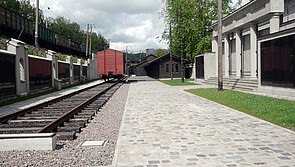


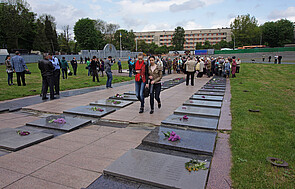
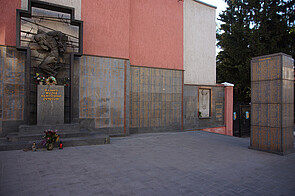


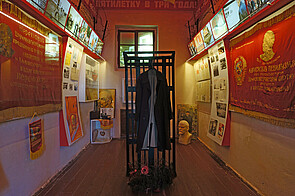
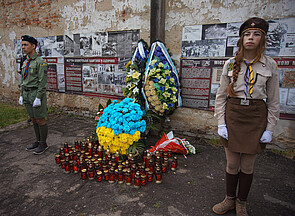
Viktoriia Nechyporuk · 13.12.2024
A Trident on the Shield: Ukraine’s Decommunization Strategy and the Case of the “Mother Ukraine” Sta...
Read more
Alexandr Voronovici · 12.08.2023
Separatism and the Uses of the Past: Politics of History in the Self-Proclaimed Republics of Donbas
Read more
Jeremy Cohen · 25.01.2023
Vladimir versus Volodymyr: Conflicting Russian and Ukrainian Application of Rus’ Heritage
Read more
Laura Eckl and Jan C. Bever · 31.08.2020
Ambivalent Memories: Commemorating 8 and 9 May in Kharkiv, Ukraine
Read more
Andrii Nekoliak · 16.01.2020
Towards Liberal Memory Politics? Discussing Recent Changes at Ukraine’s Memory Institute
Read more
Get this article as PDF download (including pictures).